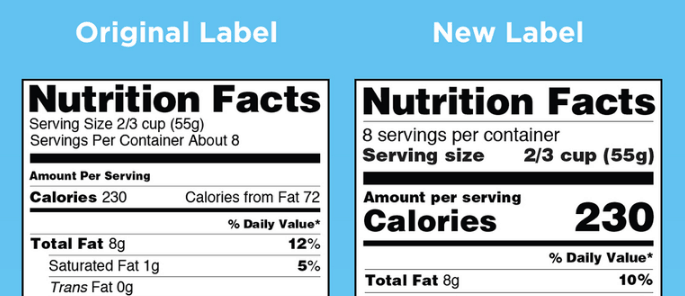In recent months you might have started to notice a new nutrition label appearing on your favorite snacks. For the first time since the Nutrition Labeling and Education Act (NLEA) passed in 1990 which required packaged foods to bear nutrition labeling, the FDA is mandating a change in the label. As of January 1, 2020 manufacturers with $10 million or more in annual sales will be required to have the updated label displayed on their products. Smaller companies with less than $10 million in annual sales will have an additional year to comply. Here is everything you need to know about this new label…
Calories will be BIG & BOLD
Not much to know here, but the calories will now be a bit easier to spot with a larger and bolded font.

Serving Size will now reflect AVERAGE helping
By law, serving sizes must be based on amounts of foods and beverages that people are actually consuming, not what they should be eating. As you might have suspected, how much people are eating has increased since 1990 when the previous serving size requirements were last published. For example, the reference amount used to set a serving of ice cream was previously 1/2 cup but is changing to 2/3 cup. The reference amount used to set a serving of soda is changing from 8 ounces to 12 ounces.
Added sugars will now be displayed
Since the beginning of nutrition labels there was one line on the label for sugar. Unless a consumer went down to the ingredient list and scoured for one or more of the 56 different names for sugar, they could not determine if the sugar in that food item was found naturally (from fruit, lactose etc.) or was added to that product for increased sweetness. With the new label, there will now be a additional line item for added sugar. This will tell consumers how much of the sugar in a product the food company added for additional sweetness. The World Health Organization recommends no more than 25g of added sugar per day and with this addition to the food label, it will be much easier for consumers to determine whether they are within the recommended limits.
Percent Daily Value Added to Sugar
On the old nutrition label, if you ran your finger across the sugar line from left to right, there would be a blank space underneath the “% daily value” column. On the updated label, food companies will now be required to tell consumers what percent of the daily recommended amount of sugar one serving of their product contains. This seems like a great improvement however, this issue is the FDA is basing their daily recommendation of sugar for all individuals off of 50g per day. This recommendation flies in the face of the World Health Organization’s recommendation of 25g of sugar per day and the American Heart Association’s recommendation of 25g/day for women and 35g/day for men.
Overall, there are some great improvements coming to our nutrition labels. With sugar being linked to obesity and many other diseases, we should be excited about the ease at with we will now be able to see just how many added grams of sugar are in our favorite products. Use this information to help you be more accountable of your nutrition and take control of your health!

